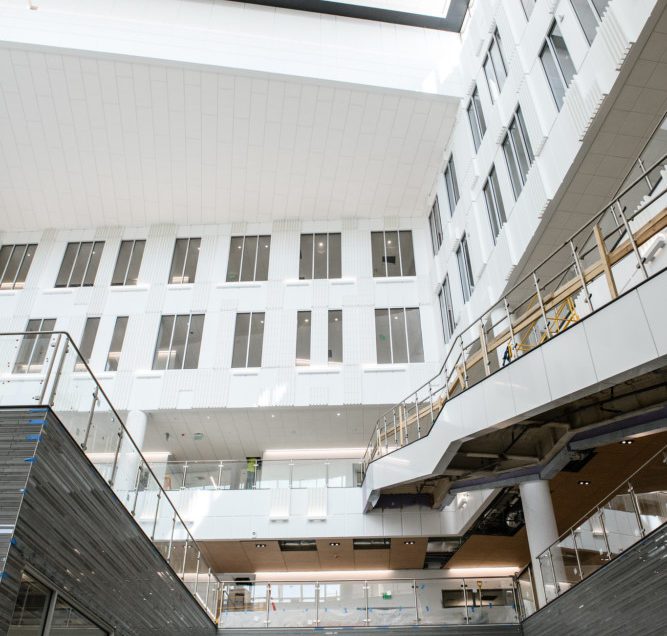 From optimized, high-tech windows with majestic views of the Blue Ridge Mountains to more than six dozen monitors that deliver almost wall-to-wall, high-definition learning, business education’s new home at Clemson University is awash in cutting-edge technology.
From optimized, high-tech windows with majestic views of the Blue Ridge Mountains to more than six dozen monitors that deliver almost wall-to-wall, high-definition learning, business education’s new home at Clemson University is awash in cutting-edge technology.
The new Wilbur O. and Ann Powers College of Business building boasts 176,000 square feet of comfortable and efficient working and learning space.
“Everything in the new building is cutting-edge – physically, mechanically and electronically,” said Paul Borick, project manager for University Facilities. “Every aspect of this building was thoroughly vetted and designed to create a functional and adaptable 21st-century learning environment.”
Design and installation of the building’s audio-visual technology was provided by TSAV (Technical Services Audio Visual), based in Athens, Ga. About 100,000 feet of cable is woven into the building, which supports 75 high-definition displays and monitors and a variety of video and audio technologies designed to support a wide array of teaching methods.
The building’s technology and room configurations accommodate team-based learning through one-person lecturing; experience-based (sales, financial markets) labs; distance learning (allowing for remote access); and independent collaborative study spaces, which are impromptu areas outside a traditional instructional environment.
“During the planning process, we gained a holistic understanding of how the building would need to operate,” said Jim Hildreth, chief of staff of TSAV. “By engaging with all of the project people and educators, we were able to design the technology to suit video and audio needs that will accommodate virtually any type of learning method.”
Exterior glass
The atrium’s glass is designed to provide brightness, be inviting and make the atrium comfortable. But it’s also energy efficient. Its tint changes throughout the day to regulate glare and thermal heat. The software behind the glass eliminates the need for blinds.
“The glass is tied to the building’s mechanical system, which is designed to create an optimal climate control environment,” Borick said. “The glass optimizes the window tint for current weather conditions, which allows for abundant interior daylight and year-round energy savings.”
[vid origin=”vimeo” vid_id=”467822306″ size=”medium” align=”left”]
Heating, air conditioning
The mechanical system that regulates the flow of warm and cool air throughout the building is highly sophisticated. The system optimizes temperatures in different building zones; it also controls for occupied and unoccupied periods and proactively identifies issues or failures throughout the building.
The system is driven by chilled water and steam from an on-campus chilled water plant. During colder periods, the system turns steam into hot water, which propels the heating system.
Lighting
The building’s lighting system employs energy-efficient LEDs, which significantly exceed code requirements for the building. The energy consumption of the interior lighting is 41 percent better than what is required by code, and the exterior lighting exceeds energy standards by 54 percent. For flexibility and energy savings, most of the lighting employs occupancy sensors and is controlled with dimmer switches. Also, classrooms and conference rooms have multiple zones for dimming lights to accommodate any teaching or presentation method.
“The planning on the technology component of this project was pivotal to the success we’ve had in creating a 21st-century environment for teaching and learning,” Borick said. “All of the University’s and industry’s resources were brought to bear to ensure the return on our investment would meet or exceed expectations.”
Get in touch and we will connect you with the author or another expert.
Or email us at news@clemson.edu

